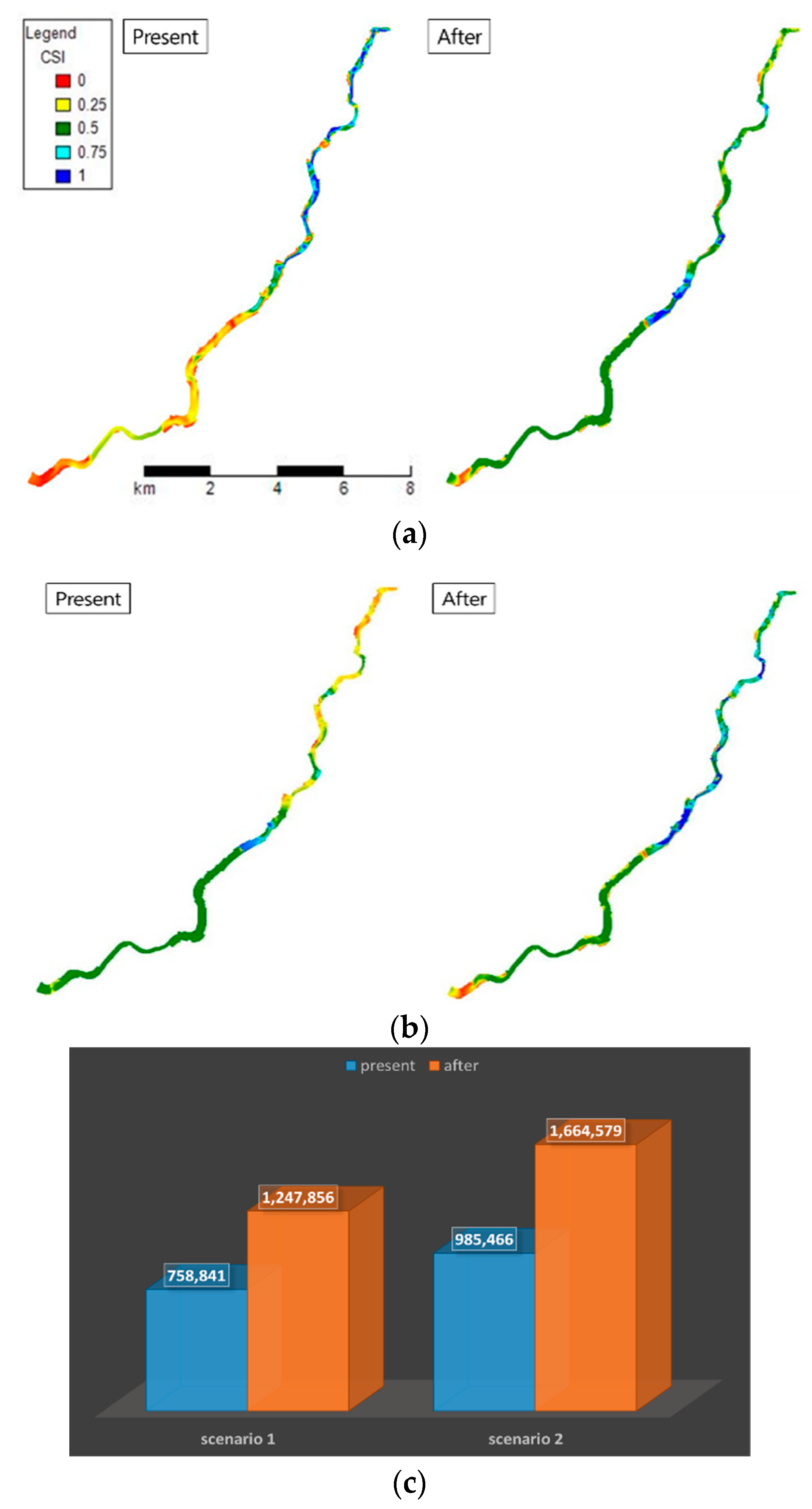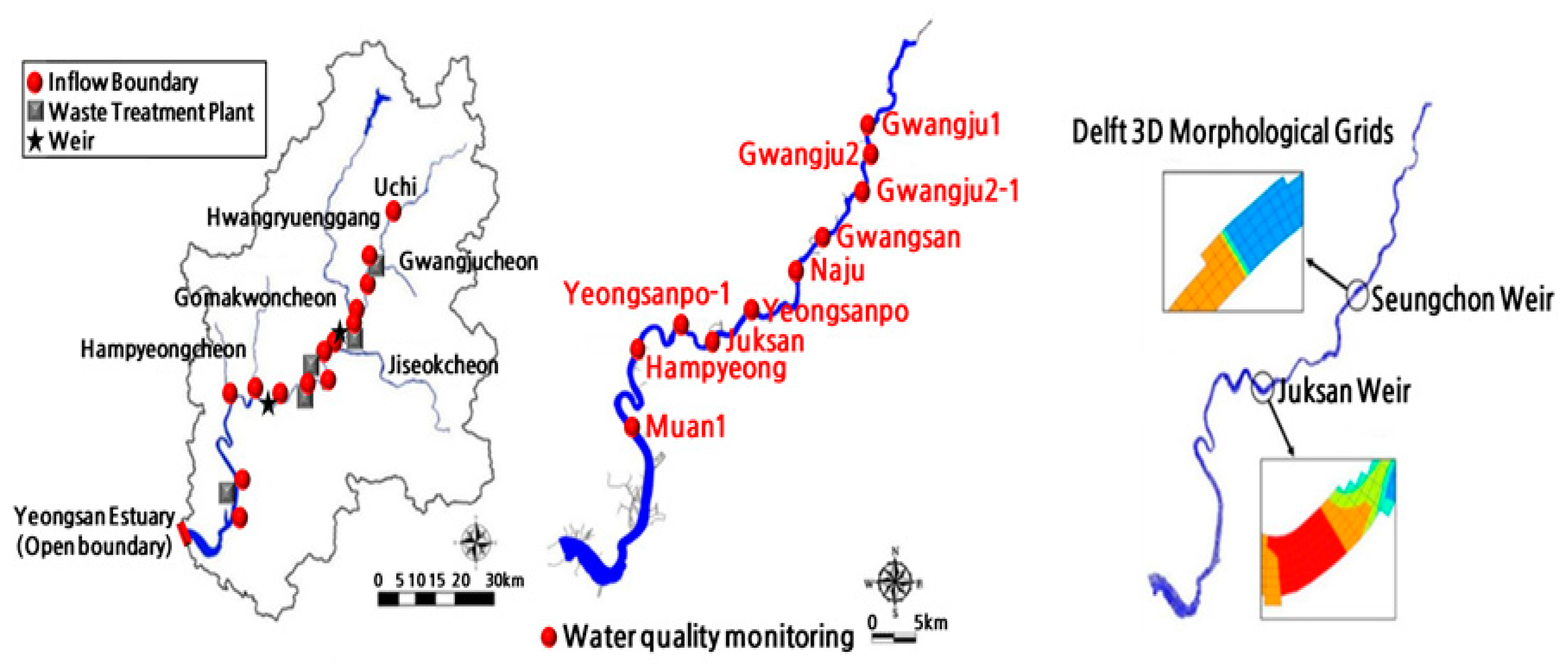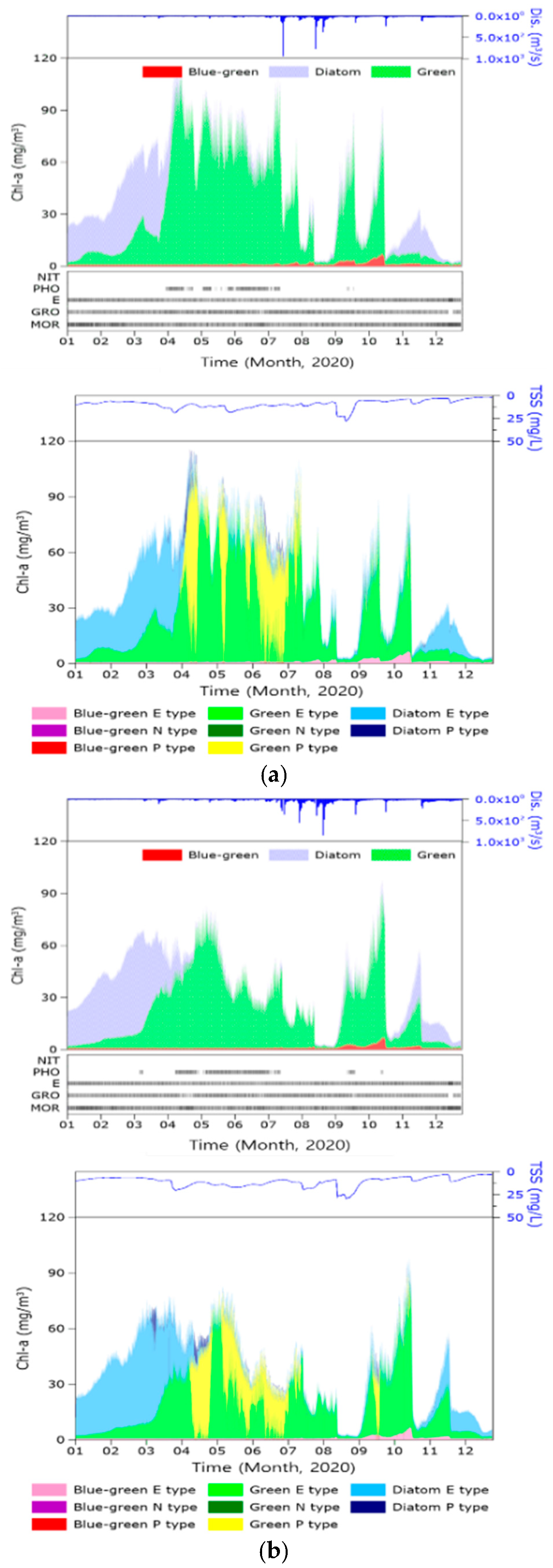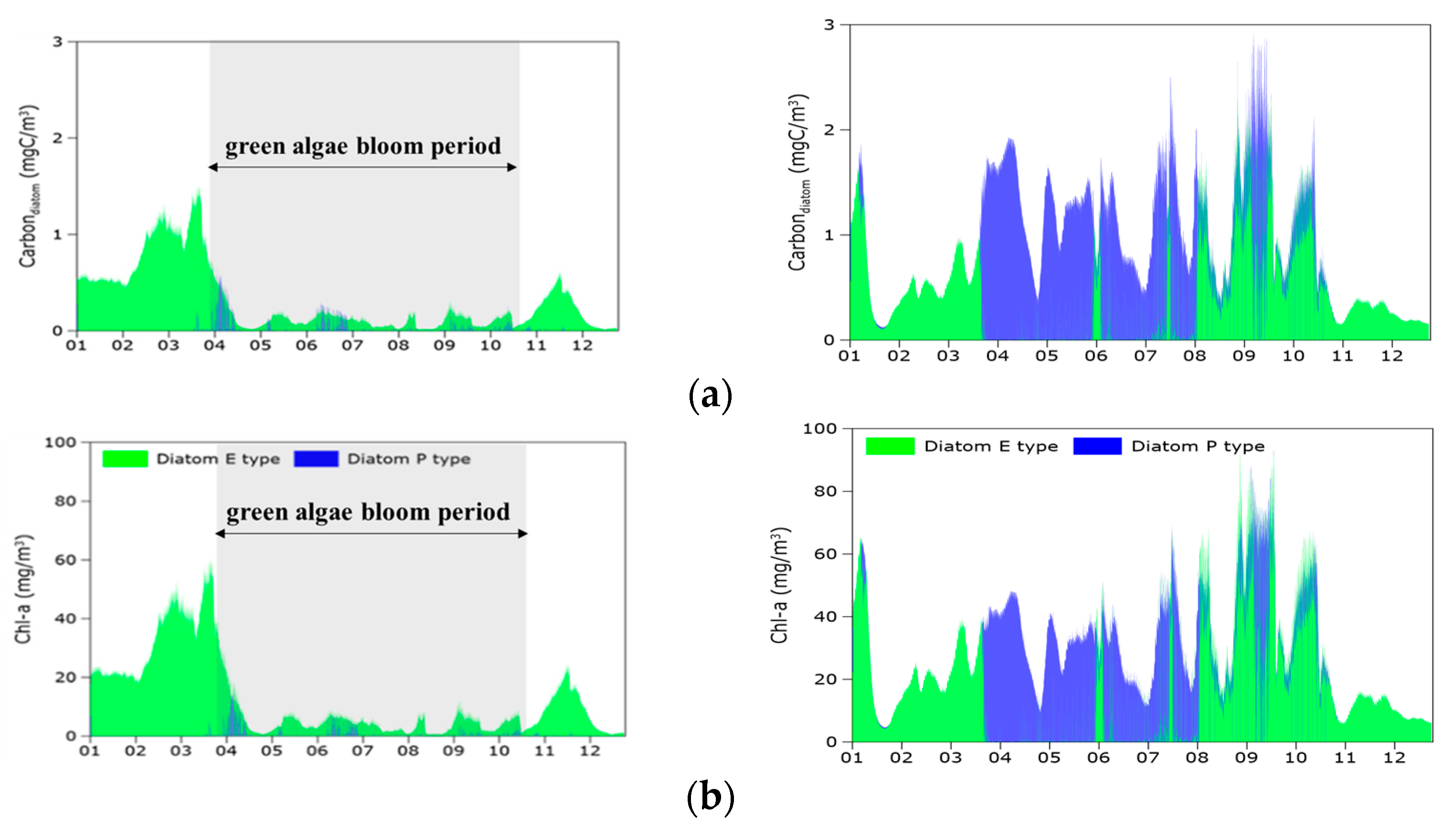Changes in Hydraulics–Water Quality–Bloom–Aquatic Habitat Using an Integrated Chain Modeling and Artificial Intelligence Technique in the Yeongsan River
Abstract
:1. Introduction
2. Materials and Methods
2.1. Study Area and Input Data
2.2. Monitoring Data
2.3. Methods
2.3.1. Hydraulic Simulation
2.3.2. Water Quality Simulation
2.3.3. Bloom Simulation
2.3.4. Habitat Simulation
2.3.5. Methods of Model Reproducibility Assessment and Scenario Development
2.3.6. Scenarios of Weir Operations
- (Condition 1) Seungchon weir partial opening (elevation: 6.0 m)—Juksan weir, full opening (elevation: −1.35 m, lowest water level)
- (Condition 2) Seungchon Weir full opening (elevation: approximately 2.7 m)—Juksan weir partial opening (mean water level elevation: 1.5 m)
2.3.7. AI Methods for Predicting Chl-a Concentrations
3. Results and Discussions
3.1. Delft3D-FLOW Model
3.2. Deft3D-WAQ-BLOOM Model
3.3. Prediction of Changes in Aquatic Ecosystems with Environmental Changes
3.3.1. Analysis of Changes in Algae with the Delft3D-BLOOM Module
3.3.2. Changes in Biological Life Cycle by Algal Type
3.3.3. Adaptation and Succession of Algae According to Weir Operation Scenarios
3.3.4. Prediction of Changes in Algae with Artificial Intelligence Models
3.3.5. Prediction of Changes in Aquatic Ecosystem Health Index through the Integrated Delft3D-HABITAT Model
- (Very high) HHS index > 80%
- (High) 50% < HHS index < 80%
- (Medium) 30% < HHS index < 50%
- (Low) 10% < HHS index < 30%
- (Very low) HHS index < 10%

4. Conclusions
Author Contributions
Funding
Institutional Review Board Statement
Informed Consent Statement
Data Availability Statement
Acknowledgments
Conflicts of Interest
References
- Lee, M.; Kim, H.; Lee, J.Y. A Shift Towards Integrated and Adaptive Water Management in South Korea: Building Resilience Against Climate Change. Water Resour. Manag. 2022, 36, 1611–1625. [Google Scholar] [CrossRef]
- Sadat, M.A.; Guan, Y.; Zhang, D.; Shao, G.; Cheng, X.; Yang, Y. The associations between river health and water resources management lead to the assessment of river state. Ecol. Indic. 2020, 109, 105814. [Google Scholar] [CrossRef]
- Ministry of Environment (MOE). The First National Water Management Plan (2021–2030); Ministry of Environment: Sejong, Republic of Korea, 2020. [Google Scholar]
- Ministry of Environment (MOE). The Second National Water Environment Management Master Plan; Ministry of Environment: Sejong, Republic of Korea, 2015. [Google Scholar]
- Bovee, K.D. A Guide to Stream Habitat Analysis Using the Instream Flow Incremental Methodology; Western Energy and Land Use Team, Office of Biological Services, Fish and Wildlife Service, US Department of the Interior: Washingtown, DC, USA, 1982. [Google Scholar]
- Wasson, J.; Tusseau-vuillemin, M.; Andréassian, V.; Perrin, C.; Faure, J.; Barreteau, O.; Bousquet, M.; Chastan, B. What kind of water models are needed for the implementation of the European Water Framework Directive? Examples from France. Int. J. River Basin Manag. 2003, 1, 125–135. [Google Scholar] [CrossRef]
- Valentin, S.; Lauters, F.; Sabaton, C.; Breil, P.; Souchon, Y. Modelling temporal variations of physical habitat for brown trout (Salmo trutta) in hydropeaking conditions. Regul. Rivers Res. Manag. 1996, 12, 317–330. [Google Scholar] [CrossRef]
- Tharme, R.E. A global perspective on environmental flow assessment: Emerging trends in the development and application of environmental flow methodologies for rivers. River Res. Appl. 2003, 19, 397–441. [Google Scholar] [CrossRef]
- Booker, D.J.; Dunbar, M.J.; Ibbotson, A. Predicting juvenile salmonid drift-feeding habitat quality using a three-dimensional hydraulic-bioenergetic model. Ecol. Model. 2004, 177, 157–177. [Google Scholar] [CrossRef]
- Colosimo, M.F.; Wilcock, P.R. Alluvial sedimentation and erosion in an urbanizing watershed, Gwynns Falls, Maryland. J. Am. Water Resour. Assoc. 2007, 43, 499–521. [Google Scholar] [CrossRef]
- García, A.; Jorde, K.; Habit, E.; Caamaño, D.; Parra, O. Downstream environmental effects of dam operations: Changes in habitat quality for native fish species. River Res. Appl. 2011, 27, 312–327. [Google Scholar] [CrossRef]
- Papadaki, C.; Ntoanidis, L.; Zogaris, S.; Martinez-Capel, F.; Muñoz-Mas, R.; Evelpidou, N.; Dimitriou, E. Habitat hydraulic modelling for environmental flow restoration in upland streams in Greece. In Proceedings of the 12th International Conference on Protection and Restoration of the Environment, Skiathos Island, Greece, 29 June–3 July 2014. [Google Scholar]
- Chen, Q.; Zhang, X.; Chen, Y.; Li, Q.; Qiu, L.; Liu, M. Downstream effects of a hydropeaking dam on ecohydrological conditions at subdaily to monthly time scales. Ecol. Eng. 2015, 77, 40–50. [Google Scholar] [CrossRef]
- Bunn, S.E.; Arthington, A.H. Basic principles and ecological consequences of altered flow regimes for aquatic biodiversity. Environ. Manag. 2002, 30, 492–507. [Google Scholar] [CrossRef] [PubMed]
- Choi, B.; Choi, S.U. Physical habitat simulations of the Dal River in Korea using the GEP Model. Ecol. Eng. 2015, 83, 456–465. [Google Scholar] [CrossRef]
- Nikghalb, S.; Shokoohi, A.; Singh, V.P.; Yu, R. Ecological regime versus minimum environmental flow: Comparison of results for a river in a semi Mediterranean region. Water Resour. Manag. 2016, 30, 4969–4984. [Google Scholar] [CrossRef]
- Im, D.; Choi, S.U.; Choi, B. Physical habitat simulation for a fish community using the ANFIS method. Ecol. Inform. 2018, 43, 73–83. [Google Scholar] [CrossRef]
- Choi, S.U.; Kim, S.K.; Choi, B.; Kim, Y. Impact of hydropeaking on downstream fish habitat at the Goesan Dam in Korea. Ecohydrology 2017, 10, e1861. [Google Scholar] [CrossRef]
- Gard, M. Modeling changes in salmon spawning and rearing habitat associated with river channel restoration. Int. J. River Basin Manag. 2006, 4, 201–211. [Google Scholar] [CrossRef]
- Schwartz, J.S.; Herricks, E.E. Evaluation of pool -riffle naturalization structures on habitat complexity and the fish community in an urban Illinois stream. River Res. Appl. 2007, 23, 451–466. [Google Scholar] [CrossRef]
- Choi, B.; Choi, S.S. Integrated hydraulic modelling, water quality modelling and habitat assessment for sustainable water management: A case study of the Anyang-Cheon stream, Korea. Sustainability 2021, 13, 4330. [Google Scholar] [CrossRef]
- Zhang, W.; Di, Z.; Yao, W.W.; Li, L. Optimizing the operation of a hydraulic dam for ecological flow requirements of the You-shui River due to a hydropower station construction. Lake Reserv. Manag. 2016, 32, 1–12. [Google Scholar] [CrossRef]
- Kang, H.; Choi, B. Dominant fish and macroinvertebrate response to flow changes of the Geum River in Korea. Water 2018, 10, 942. [Google Scholar] [CrossRef]
- Gillenwater, D.; Granata, T.; Zika, U. GIS-based modeling of spawning habitat suitability for walleye in the Sandusky River, Ohio, and implications for dam removal and river restoration. Ecol. Eng. 2006, 28, 311–323. [Google Scholar] [CrossRef]
- Tomsic, C.A.; Granata, T.C.; Murphy, R.P.; Livchak, C.J. Using a coupled eco-hydrodynamic model to predict habitat for target species following dam removal. Ecol. Eng. 2007, 30, 215–230. [Google Scholar] [CrossRef]
- Downs, P.W.; Kondolf, G.M. Post-project appraisals in adaptive management of river channel restoration. Environ. Manag. 2002, 29, 477–496. [Google Scholar] [CrossRef]
- Im, D.; Kang, H.; Kim, K.H.; Choi, S.U. Changes of river morphology and physical fish habitat following weir removal. Ecol. Eng. 2011, 37, 883–892. [Google Scholar] [CrossRef]
- Korea Institute of Civil Engineering and Building Technology (KICT). Monitoring and Evaluation of River Change (River Channel Changes); Han River Flood Control Office: Seoul, Rpublic of Korea, 2015. [Google Scholar]
- Korea Meteorological Administration (KMA). Available online: https://data.kma.go.kr/ (accessed on 31 August 2023).
- Water Environment Information System (WEIS). Available online: http://weis.nier.go.kr (accessed on 31 August 2023).
- Water Resources Management Information System (WAMIS). Available online: http://www.wamis.go.kr (accessed on 31 August 2023).
- Gosse, J.C. Microhabitat of Rainbow and Cutthroat Trout in the Green River below Flaming Gorge Dam; Utah Division of Wildlife Resources: Salt Lake City, UT, USA, 1982; p. 114. [Google Scholar]
- Deltares systems. Technical Reference Manual, D-Water Quality Processes Library Description; Delrates: Delft, The Netherlands, 2014. [Google Scholar]
- Stevens, A.W.; Lacy, J.R. The influence of wave energy and sediment transport on seagrass distribution. Estuaries Coasts 2012, 35, 92–108. [Google Scholar] [CrossRef]
- Symonds, A.M.; Vijverberg, T.; Post, S.; Van Der Spek, B.J.; Henrotte, J.; Sokolewicz, M. Comparison between Mike 21 FM, Delft3D and Delft3D FM flow models of western port bay. Aust. Coast. Eng. 2016, 2, 1–12. [Google Scholar] [CrossRef]
- Des, M.; Martinez, B.; DeCastro, M.; Viejo, R.M.; Sousa, M.C.; Gomez-Gesteira, M. The impact of climate change on the geographical distribution of habitat-forming macroalgae in the Rias Baixas. Mar. Environ. Res. 2020, 161, 105074. [Google Scholar] [CrossRef]
- Moriasi, D.N.; Arnold, J.G.; Van Liew, M.W.; Bingner, R.L.; Haemel, R.D.; Veith, T.L. Model evaluation guidelines for systematic quantification of accuracy in watershed simulations. Trans. ASABE 2007, 50, 885–900. [Google Scholar] [CrossRef]
- Los, F.J.; Wijsman, J.W.M. Application of a validated primary production model (BLOOM) as a screening tool for marine, coastal and transitional waters. J. Mar. Syst. 2007, 64, 201–215. [Google Scholar] [CrossRef]
- Los, H. Eco-Hydrodynamic Modelling of Primary Production in Coastal Waters and Lakes Using BLOOM; IOS Press: Amsterdam, The Netherlands, 2009. [Google Scholar]
- Zingraff-Hamed, A.; Noack, M.; Greulich, S.; Schwarzwälder, K.; Pauleit, S.; Wantzen, K.M. Model-based evaluation of the effects of river discharge modulations on physical fish habitat quality. Water 2018, 10, 374. [Google Scholar] [CrossRef]






| Parameter | Statistic | NSE | PBIAS (%) | Bias (El.m, mg/L) | MAE (El.m, mg/L) | IOA |
|---|---|---|---|---|---|---|
| Water level | Min | −2.05 | −1.58 | −0.08 | 0.26 | 0.84 |
| Max | 0.96 | 4.41 | 0.35 | 0.33 | 0.98 | |
| Median | 0.83 | 0.93 | 0.17 | 0.26 | 0.89 | |
| Water quality | Min | 0.66 | −1.75 | −1.42 | 0.48 | 0.66 |
| Max | 0.95 | 0.93 | 0.61 | 0.74 | 0.94 | |
| Median | 0.78 | 0.58 | 0.20 | 0.57 | 0.81 |
| Parameter | Description | Unit | Range | Setting Factor |
|---|---|---|---|---|
| SWSatOxy | Switch saturation DO calculation | - | ≤4 | 2.000 |
| ThrAlgNH4 | Threshold concentration uptake ammonium | gN/m3 | 0~1 | 0.041 |
| ThrAlgNO3 | Threshold concentration uptake nitrate | gN/m3 | 0~0.1 | 0.020 |
| ThrAlgPO4 | Threshold concentration uptake phosphate | gP/m3 | 0~0.1 | 0.015 |
| RcDen20 | MM-denitrification reaction rate at 20 °C | gN/m3/d | 0~0.1 | 0.100 |
| TcDenWat | Temperature coefficient for denitrification | - | 0.5~1.5 | 1.070 |
| KsNiDen | Half-saturation constant for nitrate cons. | gN/m3 | 0~0.1 | 0.500 |
| KsOxDen | Half-saturation constant for oxygen inhib. | g/m3 | 0~5 | 1.000 |
| KsAmNit | Half-saturation constant for ammonium cons. | gN/m3 | 0~3 | 0.500 |
| KsOxNit | Half-saturation constant for DO cons. | g/m3 | default | 1.000 |
| RcNit | First-order nitrification rate | 1/d | 0~2 | 0.140 |
| OOXNIT | Optimum oxygen concentration for nitrification | gO2/m3 | default | 5.000 |
| CFLNIT | Oxygen function level for oxygen below COXNIT | - | 0~1.5 | 0.025 |
| SWRear | Switch for oxygen reaeration formulation | - | default | 1.000 |
| TCRear | Temperature coefficient for reaeration | - | 0.5~1.8 | 1.016 |
| Algal Type | Extinction (m2/gC) | N/C (mg/mg) | P/C (mg/mg) | Si/C (mg/mg) | Chl-a/C (mg/mg) |
|---|---|---|---|---|---|
| Diatoms-E | 0.270 | 0.210 | 0.210 | 0.014 | 0.660 |
| Diatoms-P | 0.188 | 0.188 | 0.188 | 0.008 | 0.550 |
| Greens-E | 0.225 | 0.275 | 0.275 | 0.018 | 0.002 |
| Greens-N | 0.188 | 0.175 | 0.175 | 0.011 | 0.002 |
| Greens-P | 0.188 | 0.200 | 0.200 | 0.009 | 0.002 |
| Blue-green-E | 0.400 | 0.225 | 0.225 | 0.014 | 0.002 |
| Blue-green-N | 0.288 | 0.125 | 0.125 | 0.014 | 0.002 |
| Blue-green-P | 0.288 | 0.150 | 0.150 | 0.011 | 0.002 |
| Algal Type | P1 | P2 | Function Relation | M1 | M2 | R1 | R2 |
|---|---|---|---|---|---|---|---|
| Diatoms-E | 0.069 | 1.060 | 1.000 | 0.035 | 1.080 | 0.031 | 1.072 |
| Diatoms-P | 0.055 | 1.054 | 1.000 | 0.045 | 1.085 | 0.031 | 1.072 |
| Greens-E | 0.068 | 0.000 | 0.000 | 0.035 | 1.080 | 0.031 | 1.072 |
| Greens-N | 0.068 | 3.000 | 0.000 | 0.045 | 1.085 | 0.031 | 1.072 |
| Greens-P | 0.068 | 3.000 | 0.000 | 0.045 | 1.085 | 0.031 | 1.072 |
| Blue-green-E | 0.056 | 3.000 | 0.000 | 0.035 | 1.080 | 0.012 | 1.072 |
| Blue-green-N | 0.048 | 5.000 | 0.000 | 0.045 | 1.085 | 0.012 | 1.072 |
| Blue-green-P | 0.048 | 5.000 | 0.000 | 0.045 | 1.085 | 0.012 | 1.072 |
| Parameter | Model | Input Variables | Output Variable | MAPE (%) | |
|---|---|---|---|---|---|
| Seungchon Weir | Case 1 | RNN | pH, DO | Chl-a | 35.7 |
| Case 2 | LSTM | 36.4 | |||
| Juksan Weir | Case 3 | RNN | 29.8 | ||
| Case 4 | LSTM | 24.5 | |||
| Seungchon Weir | Case 5 | RNN | Temp., Water Temp., pH, Conductivity, DO, Turbidity, TOC, T-N, T-P | 8.6 | |
| Case 6 | LSTM | 10.3 | |||
| Juksan Weir | Case 7 | RNN | 7.2 | ||
| Case 8 | LSTM | 6.1 | |||
Disclaimer/Publisher’s Note: The statements, opinions and data contained in all publications are solely those of the individual author(s) and contributor(s) and not of MDPI and/or the editor(s). MDPI and/or the editor(s) disclaim responsibility for any injury to people or property resulting from any ideas, methods, instructions or products referred to in the content. |
© 2023 by the authors. Licensee MDPI, Basel, Switzerland. This article is an open access article distributed under the terms and conditions of the Creative Commons Attribution (CC BY) license (https://creativecommons.org/licenses/by/4.0/).
Share and Cite
Choi, B.; Park, J.; Kang, T.-W.; Ha, D.-W.; Hwang, S.-Y.; Lee, W.-S.; Na, E.; Choi, J. Changes in Hydraulics–Water Quality–Bloom–Aquatic Habitat Using an Integrated Chain Modeling and Artificial Intelligence Technique in the Yeongsan River. Sustainability 2023, 15, 16355. https://doi.org/10.3390/su152316355
Choi B, Park J, Kang T-W, Ha D-W, Hwang S-Y, Lee W-S, Na E, Choi J. Changes in Hydraulics–Water Quality–Bloom–Aquatic Habitat Using an Integrated Chain Modeling and Artificial Intelligence Technique in the Yeongsan River. Sustainability. 2023; 15(23):16355. https://doi.org/10.3390/su152316355
Chicago/Turabian StyleChoi, Byungwoong, Jonghwan Park, Tae-Woo Kang, Don-Woo Ha, Seong-Yun Hwang, Won-Seok Lee, Eunhye Na, and Jiyeon Choi. 2023. "Changes in Hydraulics–Water Quality–Bloom–Aquatic Habitat Using an Integrated Chain Modeling and Artificial Intelligence Technique in the Yeongsan River" Sustainability 15, no. 23: 16355. https://doi.org/10.3390/su152316355





